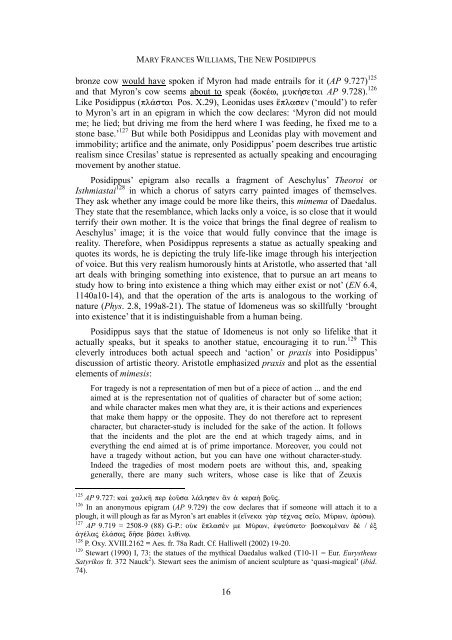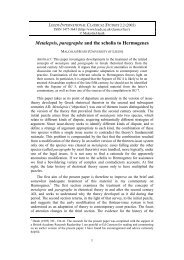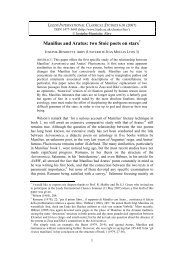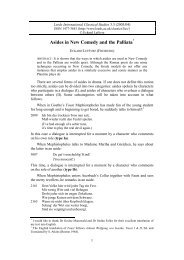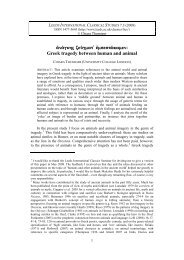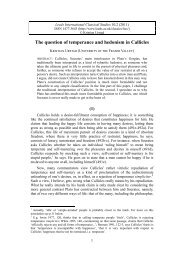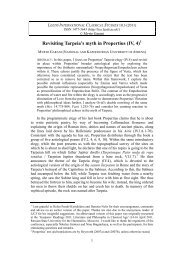The New Posidippus - Leeds International Classical Studies
The New Posidippus - Leeds International Classical Studies
The New Posidippus - Leeds International Classical Studies
You also want an ePaper? Increase the reach of your titles
YUMPU automatically turns print PDFs into web optimized ePapers that Google loves.
MARY FRANCES WILLIAMS, THE NEW POSIDIPPUS<br />
bronze cow would have spoken if Myron had made entrails for it (AP 9.727) 125<br />
and that Myron’s cow seems about to speak (dokšw, muk»setai AP 9.728). 126<br />
Like <strong>Posidippus</strong> (pl£stai Pos. X.29), Leonidas uses œplasen (‘mould’) to refer<br />
to Myron’s art in an epigram in which the cow declares: ‘Myron did not mould<br />
me; he lied; but driving me from the herd where I was feeding, he fixed me to a<br />
stone base.’ 127 But while both <strong>Posidippus</strong> and Leonidas play with movement and<br />
immobility; artifice and the animate, only <strong>Posidippus</strong>’ poem describes true artistic<br />
realism since Cresilas’ statue is represented as actually speaking and encouraging<br />
movement by another statue.<br />
<strong>Posidippus</strong>’ epigram also recalls a fragment of Aeschylus’ <strong>The</strong>oroi or<br />
Isthmiastai 128 in which a chorus of satyrs carry painted images of themselves.<br />
<strong>The</strong>y ask whether any image could be more like theirs, this mimema of Daedalus.<br />
<strong>The</strong>y state that the resemblance, which lacks only a voice, is so close that it would<br />
terrify their own mother. It is the voice that brings the final degree of realism to<br />
Aeschylus’ image; it is the voice that would fully convince that the image is<br />
reality. <strong>The</strong>refore, when <strong>Posidippus</strong> represents a statue as actually speaking and<br />
quotes its words, he is depicting the truly life-like image through his interjection<br />
of voice. But this very realism humorously hints at Aristotle, who asserted that ‘all<br />
art deals with bringing something into existence, that to pursue an art means to<br />
study how to bring into existence a thing which may either exist or not’ (EN 6.4,<br />
1140a10-14), and that the operation of the arts is analogous to the working of<br />
nature (Phys. 2.8, 199a8-21). <strong>The</strong> statue of Idomeneus was so skillfully ‘brought<br />
into existence’ that it is indistinguishable from a human being.<br />
<strong>Posidippus</strong> says that the statue of Idomeneus is not only so lifelike that it<br />
actually speaks, but it speaks to another statue, encouraging it to run. 129 This<br />
cleverly introduces both actual speech and ‘action’ or praxis into <strong>Posidippus</strong>’<br />
discussion of artistic theory. Aristotle emphasized praxis and plot as the essential<br />
elements of mimesis:<br />
For tragedy is not a representation of men but of a piece of action ... and the end<br />
aimed at is the representation not of qualities of character but of some action;<br />
and while character makes men what they are, it is their actions and experiences<br />
that make them happy or the opposite. <strong>The</strong>y do not therefore act to represent<br />
character, but character-study is included for the sake of the action. It follows<br />
that the incidents and the plot are the end at which tragedy aims, and in<br />
everything the end aimed at is of prime importance. Moreover, you could not<br />
have a tragedy without action, but you can have one without character-study.<br />
Indeed the tragedies of most modern poets are without this, and, speaking<br />
generally, there are many such writers, whose case is like that of Zeuxis<br />
125 AP 9.727: kaˆ calkÁ per oàsa l£lhsen ¨n ¡ kera¾ boàj.<br />
126 In an anonymous epigram (AP 9.729) the cow declares that if someone will attach it to a<br />
plough, it will plough as far as Myron’s art enables it (e†neka g¦r tšcnaj se‹o, MÚrwn, ¢rÒsw).<br />
127 AP 9.719 = 2508-9 (88) G-P.: oÙk œplasšn me MÚrwn, yeÚsato: boskomšnan d / x<br />
¢gšlaj l£saj dÁse b£sei liq…nJ.<br />
128 P. Oxy. XVIII.2162 = Aes. fr. 78a Radt. Cf. Halliwell (2002) 19-20.<br />
129 Stewart (1990) I, 73: the statues of the mythical Daedalus walked (T10-11 = Eur. Eurystheus<br />
Satyrikos fr. 372 Nauck 2 ). Stewart sees the animism of ancient sculpture as ‘quasi-magical’ (ibid.<br />
74).<br />
16


